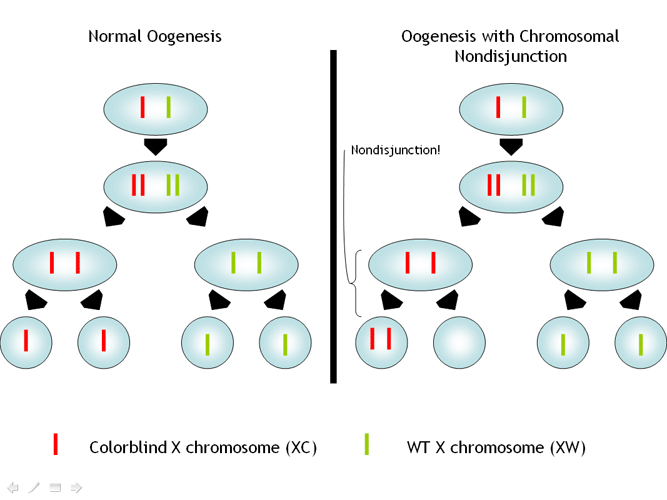Medical expert of the article
New publications
Klinefelter's syndrome
Last reviewed: 05.07.2025

All iLive content is medically reviewed or fact checked to ensure as much factual accuracy as possible.
We have strict sourcing guidelines and only link to reputable media sites, academic research institutions and, whenever possible, medically peer reviewed studies. Note that the numbers in parentheses ([1], [2], etc.) are clickable links to these studies.
If you feel that any of our content is inaccurate, out-of-date, or otherwise questionable, please select it and press Ctrl + Enter.
Klinefelter syndrome, 47,XXY is a clinical example of a sex chromosome disorder.
Klinefelter's disease is characterized by the presence of at least one extra X chromosome in boys, which leads to impaired puberty in them. It was first clinically described by Klinefelter in 1942. The population frequency is 1:1000 males. Klinefelter syndrome occurs in approximately 1/800 live-born boys. The child receives the extra X chromosome from the mother in 60% of cases.
 [ 1 ]
[ 1 ]
What causes Klinefelter's disease?
In most cases, abnormal divergence of sex chromosomes occurs in the gametes of the parents. Mosaic variants also occur, for example 47, XXY/46, XY.
Klinefelter syndrome is caused by a chromosomal abnormality, most typically represented as 47XXY. Mosaic forms, 46XY/47XXY, are much less common. The following forms are described as casuistic karyotype variants: 48XXXY, 47XXY/46XX, 47XXY/45XO. There is also an observation of a patient with the karyotype 47XXYY46XX/45XO. The cause of these chromosomal abnormalities, an additional X chromosome in the male karyotype, may be nondisjunction of the X chromosome during the first or second meiotic division or impaired mitotic divergence of chromosomes during zygote development (mosaic variants). DNA analysis revealed that 53% of patients with Klinefelter syndrome had an additional chromosome of paternal origin, which was a consequence of nondisjunction during the first meiotic division. 43% of patients had an additional chromosome of maternal origin as a result of pathology of the first and second meiotic divisions. Apparently, there are no differences in the phenotype in patients with an additional maternal or paternal X chromosome. The frequency of birth of boys with Klinefelter syndrome increases with increasing maternal age. No such dependence on paternal age was found. The presence of an additional X chromosome in the male karyotype does not affect the differentiation of testicles and the formation of male-type genitalia. However, the vital activity of germ cells is impaired, spermatogenesis is absent. The reason for this is the activity of the additional X chromosome in germ cells that normally have a haploid set of chromosomes. It has been shown that in the germ cells of the ovary of the fetus in girls, reactivation of the second X chromosome occurs before entering meiosis (normally only one is activated). In boys with the XXY karyotype, the pre-meiotic process of reactivation of the second X chromosome is also preserved, but the process of divergence is disrupted, and the germ cell may contain two active X chromosomes, which leads to its death already in the first days after the reactivation of the X chromosome. In adult men with Klinefelter syndrome, when analyzing sperm cells, single preserved germ cells had only a normal haploid chromosome set.
Pathogenesis of Klinefelter syndrome
The presence of an extra X chromosome leads to aplasia of the testicular epithelium, which subsequently becomes hyalinized. This leads to azoospermia and infertility in adult patients.

 [ 2 ]
[ 2 ]
Symptoms of Klinefelter syndrome
At birth, Klinefelter syndrome is not clinically manifested. There are many clinical variants described, concerning both anomalies of sexual status and somatic disorders in Klinefelter syndrome. No general pattern of influence of karyotype on phenotype has been identified, but patients with a mosaic karyotype with a normal male clone 47XXY/46XY have less severe disorders.
The first distinct phenotypic signs of the disease appear in the pre- and pubertal periods of ontogenesis. Before puberty, boys may have cryptorchidism (usually bilateral) and a small penis. 50% of boys have moderate mental retardation, accompanied by behavioral disorders and difficulties in contact with peers. Boys usually have a body length above average for their age. Relatively long limbs and excessive fat deposition of the female type (eunuchoid body type) are characteristic.

Secondary sexual characteristics appear late. The most characteristic symptom of Klinefelter syndrome is hypoplasia of the testicles and penis (hypogonadism and hypogenitalism). Gynecomastia is detected in 50% of patients during puberty. There is a slight decrease in intelligence, which affects school performance. Adult patients are prone to alcoholism, drug addiction, homosexuality and antisocial behavior, especially under stress.
Puberty usually begins at a normal age, but facial hair is often low. These children are predisposed to learning disabilities, and many have reduced verbal intelligence, impaired auditory perception and information processing, and impaired reading skills. Clinical variability is considerable, with many boys and men with the 47,XXY karyotype having normal appearance and normal intelligence.
In puberty, secondary hair growth appears at the usual time, and an enlargement of the penis is also noted. However, the volume of the testicles increases only slightly, usually not exceeding 8 ml; the testicles have a dense consistency. Pubertal gynecomastia, often quite early, is detected in 40-50% of boys. These patients subsequently have an increased risk of developing breast carcinoma. Bone maturation usually corresponds to the age at the time of initiation of puberty, but later differentiation of the skeletal bones is delayed due to insufficient testosterone secretion. Linear growth of the limbs continues until 18-20 years, which leads to the formation of eunuchoid body proportions; the final height of patients is usually higher than the height of their parents. Postpubertal involution of the testicles leads to hypogonadism and loss of fertility. Histological examination reveals hyalinosis of the seminiferous tubules and the absence of spermatogenesis. The number of Leydig cells may be normal, but they undergo atrophy with age.
In addition to symptoms of sexual development disorders, patients with Klinefelter syndrome may have a number of congenital bone tissue anomalies: clinodactyly, sternum deformity, cubitus valgus, coxa valga, hypertelorism, micrognathia, "gothic" palate, etc. The disease is often accompanied by congenital cardiovascular defects. Malignant neoplasms are often detected in patients, in particular, there is information about the high frequency of germ cell tumors.
Mosaicism occurs in 15% of cases. These men can have children. Some men may have 3, 4, or even 5 X chromosomes along with one Y chromosome. As the number of X chromosomes increases, the severity of mental retardation and developmental defects increases.
Diagnosis of Klinefelter syndrome
Klinefelter syndrome is often discovered during an infertility evaluation (probably all 47,XXY males are sterile). Testicular development varies from hyalinized, nonfunctioning tubular structures to some sperm production; increased urinary excretion of follicle-stimulating hormone is often noted.
If there are phenotypic signs of Klinefelter syndrome, sex chromatin is determined. If the test is positive, karyotyping is indicated. In most cases, the karyotype 47, XXY or its mosaic variant is detected. However, other cytogenetic variants of the syndrome are also encountered, for example, 48, XXXY; 48, XXYY.
 [ 8 ], [ 9 ], [ 10 ], [ 11 ], [ 12 ], [ 13 ], [ 14 ]
[ 8 ], [ 9 ], [ 10 ], [ 11 ], [ 12 ], [ 13 ], [ 14 ]
Features of gonadotropic and gonadal functions
In prepubertal age, the LH, FSH and T levels in boys with Klinefelter syndrome are usually normal. By the beginning of puberty, the FSH level increases and by the age of 14-15 years it already significantly exceeds the norm. The testosterone level by the time of puberty usually increases, but its concentration does not reach the norm. The LH level during puberty is normal, but subsequently, as the testosterone level decreases, the LH concentration increases. The reaction of LH and FSH to the introduction of GnRH is usually hyperergic in nature already in the early stages of puberty
The process of androgen deficiency formation, which is secondary to primary damage to the germinal epithelium of the testicles, is currently not fully understood. Early death of the spermatogenic epithelium leads to a deficiency of Sertoli cells that secrete inhibin, a natural regulator of FSH secretion in men. As a result, the FSH level in patients is elevated from early puberty. However, testosterone production and LH secretion are not impaired in the first years of puberty and post-puberty, only later there is a decrease in testosterone secretion and an increase in LH secretion - the development of hypergonadotropic hypogonadism. Obviously, the germinal epithelium and Sertoli cells have a certain trophic effect on the interstitial Leydig cells, and the absence of their trophic effect makes normal testosterone secretion impossible.
 [ 15 ], [ 16 ], [ 17 ], [ 18 ], [ 19 ], [ 20 ], [ 21 ], [ 22 ]
[ 15 ], [ 16 ], [ 17 ], [ 18 ], [ 19 ], [ 20 ], [ 21 ], [ 22 ]
Differential diagnosis of Klinefelter syndrome
In cases where there are signs of Klinefelter syndrome with a normal karyotype (46, XY), other forms of hypogonadism must be excluded.
Who to contact?
How is Klinefelter's disease treated?
During puberty, courses of androgens are administered, which promotes the formation of secondary sexual characteristics, but infertility is not cured.
In adolescents with Klinefelter syndrome, despite partial androgen deficiency, therapy with testosterone esters according to the standard scheme should be prescribed from the age of 13-14 years. Androgen preparations significantly improve the adaptation and intelligence of the adolescent, prevent the development of eunuchoidism. Long-term observation of adolescents with Klinefelter syndrome showed that early therapy with testosterone preparations significantly increases the intelligence of adult patients, their ability to work and social adaptation.
 [ 25 ]
[ 25 ]
Evaluation of treatment effectiveness
The criterion for treatment effectiveness is the development of secondary sexual characteristics.
Complications and side effects of treatment
The introduction of testosterone esters may cause fluid retention and agitation in the first days after injection.
Outpatient monitoring is carried out by an endocrinologist.
What is the prognosis for Klinefelter syndrome?
Klinefelter syndrome has a different prognosis and depends on the form of the disease, combined hormonal and somatic disorders. Replacement therapy with sex hormones is lifelong.
Использованная литература

